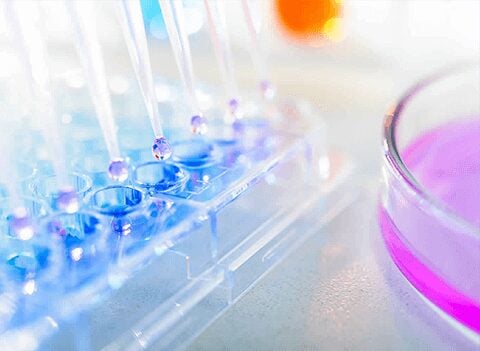Stem Cell Repository
The potential of human stem cell models for casting light on ALS disease mechanisms and for testing drug candidates is clear. Establishing this technology is a major undertaking for any individual lab, so Target ALS has worked to make it accessible to the ALS researchers in academia and pharma/biotech industry worldwide. The cell lines are provided with no reach-through on data or intellectual property.

Target ALS has created a network of contract research organizations and academic core facilities to generate and distribute new iPS cell and reporter lines. They were created through a partnership with Columbia University Irving Medical Center and research conducted by Alejandro Garcia-Diaz, Gizem Efe, Khushbu Kabra, Achchhe Patel, Emily R. Lowry, Neil Shneider, Barbara Corneo, and Hynek Wichterle, as well as Jennifer Moore and her team at Sampled.
Visit the NINDS website for more information about ordering Target ALS stem cell reporter lines from the NINDS catalog.
Stem Cell Consortium
In light of the uniquely human biology underlying amyotrophic lateral sclerosis (ALS), iPSC derived cellular models have become the gold standard for this condition (Fujimori et al. 2018) and more broadly (Kwart et al. 2019). However, there are reproducibility concerns due to variability introduced by protocol differences between labs, but also by differences in genetic background (Volpato and Webber 2020) or even sex (Workman et al. 2023). Importantly, this variability can affect disease relevant phenotypes, with some lines presenting clear ALS-related pathology and others, sometimes with the same mutation, not presenting clear phenotypes. It is extremely challenging, and a barrier to entry, to both academic and industry newcomers to the field, to select which line to use.
We seek to provide the field with a set of well-characterized human cell-based models of ALS and methods for detecting disease-relevant phenotypes. To leverage the consortium format, every model will be evaluated across two labs in order to test for reproducibility of differentiation protocols and disease phenotypes. Data, cell lines, and methods will be shared with researchers in for-profit and non-profit institutions.
The Stem Cell Core Consortium includes the following researchers:
- Sami Barmada, MD, PhD, University of Michigan
- Johnathon Cooper-Knock, PhD, University of Sheffield
- Eran Hornstein, PhD, Weizmann Institute
- Jimena Andreas, PhD, Emory University
- Joao Duarte Tavares de Silva Pereira, PhD, Yale University
Stem cell creation will be carried out by:
- Bill Skarnes, PhD, The Jackson Laboratory
- Barbara Corneo, PhD, Columbia University
This consortium proposes to characterize iPSC lines derived from ALS patients carrying key pathogenic mutations within C9ORF72 (n=2), TARDBP (n=2), FUS (n=2) and SOD1 (n=2). Although this number of lines will, ideally, be expanded, we believe that a well-characterized initial selection will then allow further researchers to expand individually on their characterization of additional lines. All iPSCs will be developed from fibroblasts in a single lab using a validated protocol. Moreover, we will generate CRISPR-corrected isogenic control lines to pair with each patient line. In addition, we will incorporate doxycycline-inducible transcription factors (TF) at safe-harbor loci, as has been previously demonstrated (Fernandopulle et al. 2018), for the reproducible generation of either cortical neurons (NGN2) or lower motor neurons (hNIL: NGN2, ISL1, and LHX3). These methods would aid reproducibility, particularly in high-throughput screening conditions.
